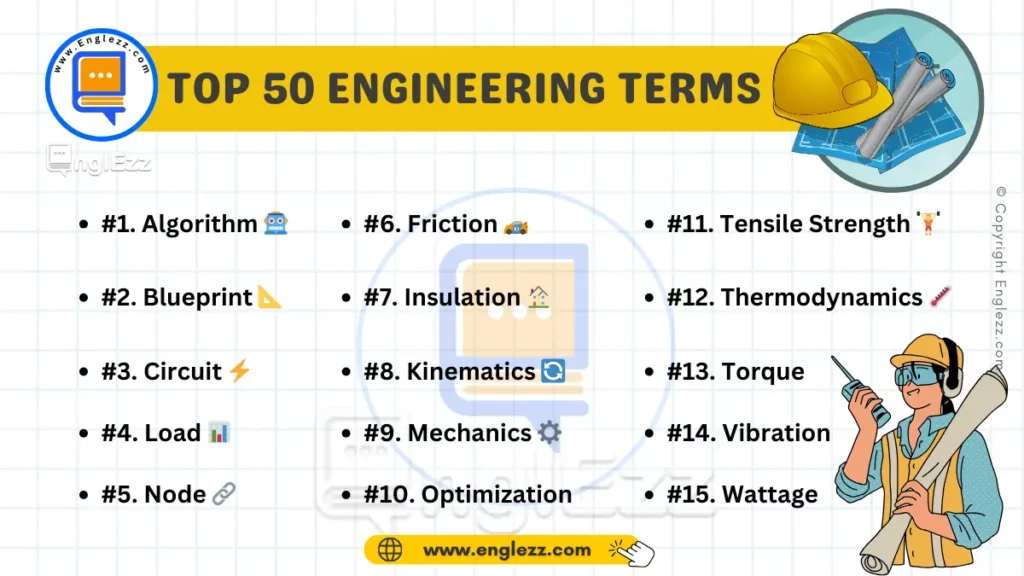Engineering is a vast field that encompasses a variety of disciplines, each with its own set of specialized terms and jargon. In this blog post, we’ll explore 50 crucial engineering terms that every student must know.
Whether you’re an aspiring engineer or a student currently navigating through engineering studies, mastering the essential vocabulary can significantly impact your understanding of the subject. Knowing these terms will not only help you in your coursework but also prepare you for professional interactions and industry-standard practices.
50 Engineering English Terms Every Student Must Know
From fundamental concepts to advanced terminologies, this comprehensive guide will serve as an invaluable resource. Each term is explained with its definition, phonetic transcription, and practical examples to ensure clarity. By familiarizing yourself with these terms, you’ll enhance your technical communication skills and improve your overall grasp of engineering principles.
#1. Algorithm 🤖
- Definition: A step-by-step procedure for calculations, data processing, and automated reasoning tasks.
- Phonetic Transcription: ˈælɡərɪðəm
- Examples:
- Algorithms are used in computer programming to solve complex problems.
- Engineers use algorithms to design efficient systems for data analysis.
#2. Blueprint 📐
- Definition: A detailed technical drawing of a building or machine.
- Phonetic Transcription: ˈbluːprɪnt
- Examples:
- The architect created a blueprint for the new skyscraper.
- Engineers refer to blueprints when assembling machinery.
#3. Circuit ⚡
- Definition: A closed path through which an electric current flows.
- Phonetic Transcription: ˈsɜːrkɪt
- Examples:
- The circuit board in the computer controls various functions.
- Electrical engineers design circuits to optimize energy use.
#4. Load 📊
- Definition: The amount of weight or force that a structure can bear.
- Phonetic Transcription: loʊd
- Examples:
- Engineers calculate the load capacity of bridges to ensure safety.
- The load on the beam needs to be assessed before construction.

#5. Node 🔗
- Definition: A point in a network where lines or pathways intersect.
- Phonetic Transcription: noʊd
- Examples:
- In computer networks, nodes are devices like computers or routers.
- Structural engineers study nodes in trusses to ensure stability.
#6. Prototype 🛠️
- Definition: An initial model of a product used for testing and development.
- Phonetic Transcription: ˈprəʊtətaɪp
- Examples:
- Engineers created a prototype of the new drone to test its flight capabilities.
- The prototype of the electric vehicle was tested for efficiency.
#7. Stress 💪
- Definition: The internal resistance of a material to deformation or failure.
- Phonetic Transcription: strɛs
- Examples:
- Material stress is analyzed to prevent structural failures.
- Engineers measure stress to ensure components withstand operational forces.
#8. Torque 🔧
- Definition: A measure of rotational force applied to an object.
- Phonetic Transcription: tɔːrk
- Examples:
- Mechanics calculate torque to ensure bolts are tightened properly.
- The torque applied to the engine affects its performance.
#9. Velocity 🚀
- Definition: The speed of something in a given direction.
- Phonetic Transcription: vəˈlɒsɪti
- Examples:
- Engineers measure the velocity of vehicles for safety tests.
- The velocity of fluid flow is crucial in designing pipelines.
#10. Voltage 🔋
- Definition: The electrical potential difference between two points.
- Phonetic Transcription: ˈvoʊltɪdʒ
- Examples:
- Voltage regulators maintain stable power supply in electronic devices.
- The voltage across a circuit affects the current flow.
#11. Friction 🏎️
- Definition: The resistance encountered when two surfaces slide against each other.
- Phonetic Transcription: ˈfrɪkʃən
- Examples:
- Engineers analyze friction to design better braking systems.
- Friction between gears affects the efficiency of machinery.
#12. Insulation 🏠
- Definition: Material used to prevent heat or electrical energy from escaping.
- Phonetic Transcription: ˌɪnsəˈleɪʃən
- Examples:
- Thermal insulation is essential in building construction to maintain temperature.
- Electrical insulation prevents short circuits in wiring.
#13. Kinematics 🔄
- Definition: The study of motion without considering the forces that cause it.
- Phonetic Transcription: ˌkɪnəˈmætɪks
- Examples:
- Kinematics helps engineers design robotic arms with precise movements.
- The study of kinematics is crucial in vehicle dynamics analysis.
#14. Mechanics ⚙️
- Definition: The branch of physics dealing with forces and the motion of objects.
- Phonetic Transcription: məˈkænɪks
- Examples:
- Mechanics principles are applied in the design of various engineering systems.
- Structural mechanics helps in analyzing building stability.
#15. Optimization 📈
- Definition: The process of making a system as effective or functional as possible.
- Phonetic Transcription: ˌɒptɪmaɪˈzeɪʃən
- Examples:
- Optimization techniques are used to improve manufacturing processes.
- Engineers use optimization to enhance the performance of algorithms.
#16. Parameter 📏
- Definition: A numerical or other measurable factor used in calculations or settings.
- Phonetic Transcription: pəˈræmɪtə(r)
- Examples:
- Parameters in a simulation model control the accuracy of predictions.
- Setting the correct parameters is crucial for accurate engineering measurements.
#17. Quantitative 📊
- Definition: Relating to the measurement of quantity or amount.
- Phonetic Transcription: ˌkwɒntɪˈteɪtɪv
- Examples:
- Quantitative analysis helps in evaluating engineering designs.
- Engineers use quantitative methods to assess material properties.
#18. Resistance 🛡️
- Definition: The opposition offered by a material to the flow of electric current.
- Phonetic Transcription: rɪˈzɪstəns
- Examples:
- Electrical resistance affects the efficiency of circuits.
- Engineers consider resistance in the design of electrical components.
#19. Simulation 💻
- Definition: The imitation of a real-world process or system through a model.
- Phonetic Transcription: ˌsɪmjuˈleɪʃən
- Examples:
- Engineers use simulation software to test the performance of new designs.
- Simulations are crucial in predicting the behavior of complex systems.
#20. Stress Analysis 🔬
- Definition: The study of how forces affect materials and structures.
- Phonetic Transcription: strɛs əˈnælɪsɪs
- Examples:
- Stress analysis ensures that bridges can handle heavy loads.
- Engineers perform stress analysis on aircraft wings to ensure safety.
#21. Tensile Strength 🏋️
- Definition: The maximum stress a material can withstand while being stretched or pulled.
- Phonetic Transcription: ˈtɛnsəl strɛŋθ
- Examples:
- Tensile strength is important in selecting materials for construction.
- Engineers test the tensile strength of cables to ensure durability.
#22. Thermodynamics 🌡️
- Definition: The study of the relationship between heat, work, and energy.
- Phonetic Transcription: ˌθɜːrmoʊdaɪˈnæmɪks
- Examples:
- Thermodynamics principles are used in designing engines and power plants.
- Engineers apply thermodynamics to improve energy efficiency.
#23. Torque 🔩
- Definition: A measure of the rotational force applied to an object.
- Phonetic Transcription: tɔːrk
- Examples:
- Engineers calculate the torque required to turn a gear.
- The torque on a vehicle’s wheels affects its acceleration.
#24. Vibration 🎶
- Definition: The oscillation of an object around a central point.
- Phonetic Transcription: vaɪˈbreɪʃən
- Examples:
- Engineers analyze vibrations to prevent damage in machinery.
- Vibration testing is used to ensure the reliability of electronic devices.
#25. Wattage ⚡
- Definition: The amount of power used or generated, measured in watts.
- **Ph
onetic Transcription:** ˈwɒtɪdʒ
- Examples:
- The wattage of a light bulb determines its brightness.
- Engineers calculate wattage requirements for electrical systems.
#26. Yield Strength 📏
- Definition: The amount of stress a material can withstand before permanent deformation.
- Phonetic Transcription: jiːld strɛŋθ
- Examples:
- Yield strength is a critical factor in material selection for structural components.
- Engineers test yield strength to ensure safety and performance of materials.
#27. Compliance ✅
- Definition: The ability of a material to deform under stress and return to its original shape.
- Phonetic Transcription: kəmˈplaɪəns
- Examples:
- Engineers design compliant materials for shock absorption in vehicles.
- Compliance testing ensures that materials meet safety regulations.
#28. Flow Rate 🚰
- Definition: The volume of fluid passing through a system per unit time.
- Phonetic Transcription: floʊ reɪt
- Examples:
- Flow rate is crucial in designing efficient water supply systems.
- Engineers measure flow rate to optimize industrial processes.
#29. Heat Transfer 🔥
- Definition: The process of energy moving from a warmer area to a cooler one.
- Phonetic Transcription: hiːt ˈtrænzfə(r)
- Examples:
- Heat transfer calculations are important in designing cooling systems.
- Engineers use heat transfer principles in thermal management of electronic devices.
#30. Hydraulics 💧
- Definition: The study of fluid mechanics used in engineering systems.
- Phonetic Transcription: haɪˈdrɔːlɪks
- Examples:
- Hydraulics are used in the design of excavators and cranes.
- Engineers apply hydraulics principles to improve braking systems in vehicles.
#31. Instrumentation 🛠️
- Definition: The use of instruments for measuring and controlling physical quantities.
- Phonetic Transcription: ˌɪnstrəmenˈteɪʃən
- Examples:
- Engineers use instrumentation to monitor environmental conditions.
- Instrumentation is crucial for accurate data collection in scientific experiments.
#32. Latent Heat 🌡️
- Definition: The heat required to change a substance’s phase without changing its temperature.
- Phonetic Transcription: ˈleɪtənt hiːt
- Examples:
- Latent heat is considered in the design of refrigeration systems.
- Engineers calculate latent heat for efficient energy storage solutions.
#33. Modulus of Elasticity 🧲
- Definition: A measure of a material’s ability to return to its original shape after deformation.
- Phonetic Transcription: ˈmɒdjələs əv ɪˈlæstɪsɪti
- Examples:
- Engineers use modulus of elasticity to select materials for structural applications.
- The modulus of elasticity affects the flexibility of materials in product design.
#34. Resonance 🔊
- Definition: The tendency of a system to oscillate with greater amplitude at certain frequencies.
- Phonetic Transcription: ˈrɛzənəns
- Examples:
- Engineers study resonance to prevent structural failures in bridges.
- Resonance is considered in the design of musical instruments.
#35. Seismic 🌍
- Definition: Relating to or caused by earthquakes or other vibrations of the earth.
- Phonetic Transcription: ˈsaɪzmɪk
- Examples:
- Seismic analysis is crucial in designing earthquake-resistant buildings.
- Engineers use seismic data to assess the stability of structures.
#36. Shear Force 🔧
- Definition: A force that causes different parts of a material to slide past each other.
- Phonetic Transcription: ʃɪər fɔːrs
- Examples:
- Shear force analysis is used in the design of structural beams.
- Engineers measure shear force to ensure the integrity of construction materials.
#37. Strain 🧪
- Definition: The deformation of materials in response to applied stress.
- Phonetic Transcription: streɪn
- Examples:
- Strain gauges are used to measure deformation in materials.
- Engineers analyze strain to predict the performance of materials under load.
#38. Stress Concentration 📉
- Definition: The occurrence of higher stress in localized areas of a material.
- Phonetic Transcription: strɛs kənˌsɛntrəˈteɪʃən
- Examples:
- Stress concentration analysis helps in identifying potential failure points in structures.
- Engineers design components to minimize stress concentrations.
#39. Thermal Conductivity 🌡️
- Definition: The measure of a material’s ability to conduct heat.
- Phonetic Transcription: ˈθɜːrməl kənˈdʌktɪvɪti
- Examples:
- Thermal conductivity is important in selecting materials for insulation.
- Engineers calculate thermal conductivity to ensure efficient heat dissipation in electronics.
#40. Transducer 📡
- Definition: A device that converts one form of energy into another.
- Phonetic Transcription: trænzˈduːsə(r)
- Examples:
- Transducers are used in sensors to measure physical quantities.
- Engineers use transducers in control systems to monitor and adjust parameters.
#41. Viscosity 🌡️
- Definition: The measure of a fluid’s resistance to flow.
- Phonetic Transcription: vɪsˈkɒsɪti
- Examples:
- Viscosity is a key factor in designing efficient lubrication systems.
- Engineers measure viscosity to optimize fluid flow in pipelines.
#42. Waveform 🌊
- Definition: The shape and form of a signal or wave as it travels through space or a medium.
- Phonetic Transcription: ˈweɪvfɔːrm
- Examples:
- Engineers analyze waveforms in signal processing to improve communication systems.
- The waveform of an audio signal affects sound quality in speakers.
#43. Work Done ⚙️
- Definition: The amount of energy transferred by a force moving an object over a distance.
- Phonetic Transcription: wɜːrk dʌn
- Examples:
- Engineers calculate work done to design efficient machinery.
- Work done in lifting a weight is measured to determine energy consumption.
#44. Yield Point 📈
- Definition: The stress at which a material begins to deform permanently.
- Phonetic Transcription: jiːld pɔɪnt
- Examples:
- The yield point is used to predict material behavior under load.
- Engineers consider the yield point when designing structural components.
#45. Zoning 🗺️
- Definition: The process of dividing an area into sections for specific purposes.
- Phonetic Transcription: ˈzoʊnɪŋ
- Examples:
- Zoning is used in urban planning to allocate space for residential, commercial, and industrial use.
- Engineers use zoning in environmental assessments to manage land use.
#46. Absorption 🧪
- Definition: The process of taking in or soaking up a substance, such as heat or sound.
- Phonetic Transcription: əbˈsɔːrpʃən
- Examples:
- Engineers use absorption materials to reduce noise in buildings.
- Heat absorption is considered in designing thermal insulation systems.
#47. Compression 🔩
- Definition: The process of pressing or squeezing materials to reduce their volume.
- Phonetic Transcription: kəmˈprɛʃən
- Examples:
- Compression testing helps determine the strength of materials under pressure.
- Engineers design compression systems for efficient material handling.
#48. Deformation 🔧
- Definition: The alteration of the shape or size of an object under stress.
- Phonetic Transcription: ˌdiːfɔːˈmeɪʃən
- Examples:
- Engineers study deformation to ensure structural integrity.
- Material deformation is analyzed to improve the design of mechanical components.
#49. Efficiency ⚙️
- Definition: The ratio of useful work done to the total energy input.
- Phonetic Transcription: ɪˈfɪʃənsi
- Examples:
- Engineers aim to improve the efficiency of engines and machinery.
- Efficiency calculations are used to optimize energy use in systems.
#50. Load Bearing 🏗️
- Definition: The capacity of a structure to support weight or stress without failing.
- Phonetic Transcription: loʊd ˈbɛərɪŋ
- Examples:
- Load-bearing walls support the weight of the floors above in a building.
- Engineers assess load-bearing capacities to ensure the safety of bridges.
Engineering English Terms Table
| #1. Algorithm 🤖 | #11. Friction 🏎️ | #21. Tensile Strength 🏋️ |
| #2. Blueprint 📐 | #12. Insulation 🏠 | #22. Thermodynamics 🌡️ |
| #3. Circuit ⚡ | #13. Kinematics 🔄 | #23. Torque 🔩 |
| #4. Load 📊 | #14. Mechanics ⚙️ | #24. Vibration 🎶 |
| #5. Node 🔗 | #15. Optimization 📈 | #25. Wattage ⚡ |
| #6. Prototype 🛠️ | #16. Parameter 📏 | #26. Yield Strength 📏 |
| #7. Stress 💪 | #17. Quantitative 📊 | #27. Compliance ✅ |
| #8. Torque 🔧 | #18. Resistance 🛡️ | #28. Flow Rate 🚰 |
| #9. Velocity 🚀 | #19. Simulation 💻 | #29. Heat Transfer 🔥 |
| #10. Voltage 🔋 | #20. Stress Analysis 🔬 | #30. Hydraulics 💧 |
Conclusion
Understanding engineering terminology is crucial for both academic success and professional competency in the field. Mastery of these 50 essential engineering terms will provide you with a solid foundation in the language of engineering, helping you communicate effectively and solve complex problems with confidence.
From the basic concepts of stress and strain to the intricate details of thermodynamics and hydraulics, this vocabulary will enhance your ability to grasp engineering principles and apply them in practical scenarios.
As you continue your studies and career in engineering, keep these terms in mind as they will be frequently encountered in textbooks, lectures, and industry practices.
By building a strong vocabulary, you’ll be better prepared to tackle engineering challenges and contribute to innovative solutions. Stay curious and keep learning to excel in this dynamic and exciting field!









🔍📘Unlock your engineering potential with our essential guide! 🚀 Discover the top 50 engineering terms every student must know, complete with definitions and real-world examples. Enhance your knowledge and stay ahead in your studies by diving into our comprehensive list. For more insights, follow and like @EnglEzz!
.
https://www.englezz.com/50-essential-engineering-english-terms/
#englezz #vocabulary #linguistics #engineering #studentlife #academic #education #tech #learn